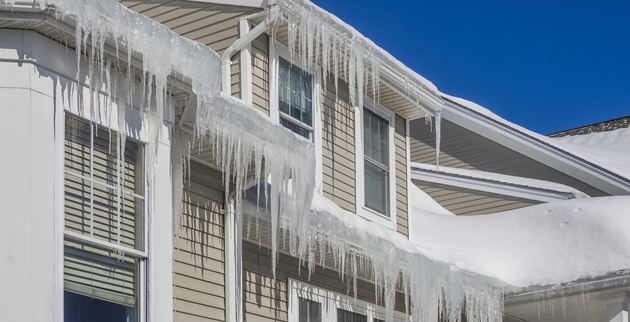

Icicles are often the first sign of a problem that may be the result of Ice Dams. Avoid the hassle of costly repairs by following the following tips and Live Assured with Preferred Mutual.
What is an Ice Dam?
Ice dams are the result of heat escaping your home through the attic or ceiling and melting the snow on your roof. This causes water to run down your roof and re-freeze at the edge where it is colder. As ice builds-up, it causes an “ice dam” which blocks water from draining off your roof.
The Danger of Ice Dams
When water runs off your roof and becomes trapped by an ice dam, it backs up on the roof, pools, freezes and expands often forcing its way under the shingles. As the process of thawing and re-freezing continues throughout the warmth of winter days and the cold of winter nights, water is forced into the attic, onto ceilings and down inside walls often causing extensive damage and costly repairs. Such damage can impact the underlying support structure to the roof, cause wood to rot, moldy insulation, destroyed drywall, electrical damage, and stained or ruined flooring.
Prevent Ice Dams from Developing
Inspect Your Homes Insulation & Stop Air Leaks
Insufficient insulation and air leaks are the primary reason for the formation of ice dams. The best way to prevent ice dams is to maintain a cold roof. Use sufficient insulation in the attic to keep the warm inside air from leaking into the attic and warming the roof. Building codes for insulation R-values vary from region to region. Homeowners should check the amount of fiberglass or cellulose insulation recommended according to the building codes in their community, and ensure that any cut-out areas around pipes, vents and ceiling fixtures are sealed with foam or caulk to prevent air leaks. Maintaining a cool, well-ventilated attic space that will not allow the roof to warm is also a good way to prevent the formation of ice dams.
Remove the Snow from Your Roof
Perhaps the most effective way to prevent the formation of ice dams is to remove any accumulation after each heavy snowfall. If your home has a low-sloped roof, a heavy-duty broom can be used to push the snow off your roof. If your house has a steep slope, you might want to use a roof rake instead (which is a scraper designed specifically to remove snow from your roof).
Consider Installing a Metal Roof in the Future
While an update like this might not initially be in the home-improvement budget, installing a metal roof on a home in an area prone to heavy snowfall could save you money and hassle in the long term. While ice can still form on a metal roof, the material will not allow water to seep into your home and will protect your insulation and ceiling from rot and mold.
The following sources should be checked for heat loss into the attic
- Ceiling light fixtures
- All plumbing and heating penetrations
- Attic hatches and pull-down stairs
- Drop-ceilings over bathtubs, closets and cabinets, and kitchen soffits
- Where walls are not completely sealed (attic stairway, interior partition walls, etc.)
- Electrical and phone cables, electrical boxes, and fan housings, such as exhaust fans
- Skylights
What to do if you do get an Ice Dam
- If you see water staining a wall or ceiling, act quickly to avoid extensive damage
- Hire a contractor to carefully remove the snow from the roof above the ice dam and create a groove in the ice dam to allow the pooling water to drain
- Do not chop or chip away at the ice dam as the roof shingles can be damaged
- Do not use salt or calcium chloride to melt the snow of the roof as these chemicals are very corrosive.
Take preventative measures to ensure that your home's infrastructure is protected from ice dams. The investment you make in your home, as well as your family’s safety, security, and peace of mind will enable you to Live Assured.